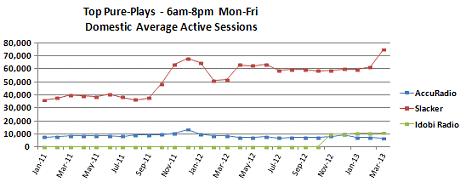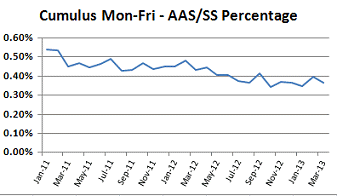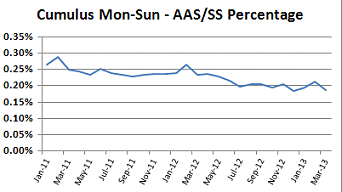| Friday, May 10, 2013 |  |
 |
 |
 |
 |
 |
 
 
 |
 |


 A New Breed of Indie Artists
A New Breed of Indie Artists Free Music and Programs for Radio and Podasters
Free Music and Programs for Radio and PodastersClarity for Online Radio Rankings
|
Have you noticed how quickly the reports of online radio rankings surface, then disappear? Issued on Wednesday by Triton Digital, its Webcast Metrics have all but vanished from radio industry trades. It's possibly an indication that the value of these numbers means little without a deep dive into what the data represents. What follows is not designed to discredit Triton Digital, or its efforts in gathering what is the only collection of listening patterns to radio online. The company does an admirable job. Where the problems lie is that, to date, little effort has been placed in understanding what this report means. (Essentially it's a collection of Triton clients, with massive holes in representing a growing online radio world - but you won't read that anywhere.) |
"Through Audio Graphics' analysis you see the one variable that matters in March: With the exception of Slacker, every company declined its 'Percentage of Average Active Sessions Resulting from Stream Starts.' (ESPN maintained its 0.27% ratio February to March, in its Monday through Friday chart, but slid from 0.15% to 0.14% Monday through Sunday.)" Receive Free Breakouts |
Explained here in April were the only two metrics that matter within these reports: 1) Average Time Spent Listening, which gives an indication of how long the audience sticks around; 2) The Percentage of Average Active Sessions Resulting from Stream Starts, a stat that tells you how many people stick around after tuning in.
All other data - which means Average Active Sessions, Session Starts - is representative of nothing concrete; it may or may not come from audience gain/loss, or it may or may not come from each group adding or subtracting streams. There's no indication within the report that defines what causes an increase or decrease and, as such, no definition of the data's meaning can be derived.
I introduced "Percentage of Average Active Sessions Resulting from Stream Starts" as a way to gauge how a particular client was doing, within the monthly report. It is there that we will focus from now on.
Through Audio Graphics' analysis you see the one variable that matters in March: With the exception of Slacker, every company declined in its "Percentage of Average Active Sessions Resulting from Stream Starts." (ESPN maintained a 0.27% ratio February to March in its Monday through Friday chart, but slid from 0.15% to 0.14% Monday through Sunday.)
If you wish to view Triton Digital Webcast Metrics charted in ways unavailable to you from any other source, subscribe to our free report.
Use the following to get a sense of just how far away terrestrial players are from the online leader, Pandora, and as a means of gauging decline in "Percentage of Average Active Sessions Resulting from Stream Starts."
With consideration given to a simple fact, it becomes clear the radio industry needs assistance in building its online audience. Each broadcaster has a promotional tool in its over-the-air signal to drive traffic online. Each pureplay operator depends on word of mouth or well executed online campaigns for the same.
First view the 6x lead that Pandora has over its nearest broadcast competitor, Clear Channel.

Here is how Slacker performed, post upgraded. It proves that enhancing a station's online presence can have positive impact.

This charts second-tier broadcasters' online performances; considering each promotes its online presence over the air, these numbers should be higher.

Now, just a quick look at two of the dozens of charts available, free, when you subscribe to Audio Graphics' breakout of online rankings. In this case it's Cumulus.



Receive our free breakout. You'll see graphs for each of the top companies charted in ways unavailable to you from any other source.
You'll also receive spreadsheets outlining the "Percentage of Average Active Sessions Resulting from Stream Starts."
Click here to receive a FREE breakout of this report sent to you for each month it is published. The Audio Graphics compiled numbers include all groups in the publicly-released Triton Digital Ranker.
Note: For caveats pertaining to this month's release, please view the bottom of Triton Digital's report.
While the broadcast side of radio has a near lockout on indie artists, introducing music is open wide to internet stations.
|
A Country artist to consider: Paul Tolle. |
 sample song |
Cougar Snack Download Song
|
Give Paul Tolle's "Cougar Snack" a listen.
Add it to your playlist, free! Such is the new world of music distribution.
The radio industry had its shot. It's time internet radio programmers take a chance and reach into a huge pile of talent. It is there that new hit songs will increasingly be found.
More Articles
 |
 |
 |
comments by Disqus |



